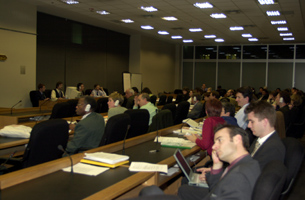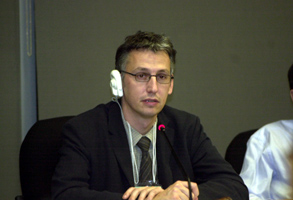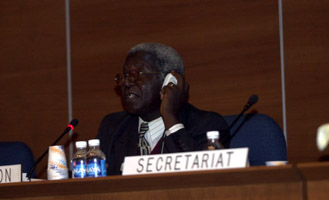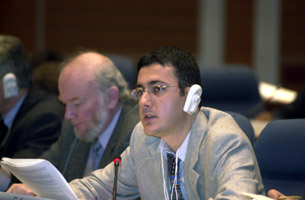|
7th
Meeting of the Subsidiary Bodies for Scientific, Technical and
Technological Advice (SBSTTA) of the Convention on Biodiversity
(CBD) |
||
|
|
||
| Highlights for Thursday, 15 November 2001 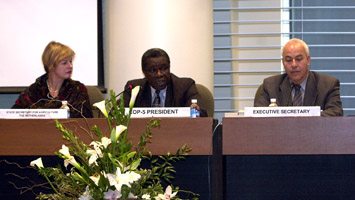 Delegates
to the seventh meeting of the Subsidiary Body for Scientific, Technical
and Technological Advice (SBSTTA) to the Convention on Biological
Diversity (CBD) met in two working groups and two contact groups. Working
Group I (WG-I) met in a brief afternoon session to address recommendations
to COP-6 and convened two contact groups that met throughout the day and
into the evening to draft text on elements of the work programme on forest
biodiversity. Working Group II (WG-II) reviewed draft recommendations on:
agricultural biodiversity; the plant conservation strategy; incentive
measures; indicators; and environmental impact assessment (EIA). The
Secretariat also launched its first Global Biodiversity Outlook (GBO).
Above photo L-R: The Global Biodiversity Outlook was launched by Geke
Faber, State Secretary for Agriculture, Nature Management and Fisheries
(NETHERLANDS), Reuben Olembo on behalf of COP-5 president and Hamdallah
Zedan, CBD Executive Secretary Delegates
to the seventh meeting of the Subsidiary Body for Scientific, Technical
and Technological Advice (SBSTTA) to the Convention on Biological
Diversity (CBD) met in two working groups and two contact groups. Working
Group I (WG-I) met in a brief afternoon session to address recommendations
to COP-6 and convened two contact groups that met throughout the day and
into the evening to draft text on elements of the work programme on forest
biodiversity. Working Group II (WG-II) reviewed draft recommendations on:
agricultural biodiversity; the plant conservation strategy; incentive
measures; indicators; and environmental impact assessment (EIA). The
Secretariat also launched its first Global Biodiversity Outlook (GBO).
Above photo L-R: The Global Biodiversity Outlook was launched by Geke
Faber, State Secretary for Agriculture, Nature Management and Fisheries
(NETHERLANDS), Reuben Olembo on behalf of COP-5 president and Hamdallah
Zedan, CBD Executive Secretary |
. |
|
|
||||||||||||||||||||||||||||||||
|
|
||
|
WORKING
GROUP I |
||
| FOREST BIOLOGICAL DIVERSITY: | ||
 The
chair of the previous evening's contact group noted consideration of:
programme elements on knowledge, assessment and monitoring; and
conservation, sustainable use and benefit-sharing. Chair Paula Warren (New
Zealand) then proposed that WG-I split into two contact groups to address
the programme elements on conservation, sustainable use and
benefit-sharing; and on institutional and socioeconomic enabling
environments. She also proposed that the Ad hoc Technical Expert
Group's (AHTEG) report be used to develop the relevant actors,
timeframes and process targets for consideration by COP-6. The
chair of the previous evening's contact group noted consideration of:
programme elements on knowledge, assessment and monitoring; and
conservation, sustainable use and benefit-sharing. Chair Paula Warren (New
Zealand) then proposed that WG-I split into two contact groups to address
the programme elements on conservation, sustainable use and
benefit-sharing; and on institutional and socioeconomic enabling
environments. She also proposed that the Ad hoc Technical Expert
Group's (AHTEG) report be used to develop the relevant actors,
timeframes and process targets for consideration by COP-6. |
||
| CONSERVATION, SUSTAINABLE USE AND BENEFIT-SHARING: | ||
|
|
||
|
|
||
|
|
||
| INSTITUTIONAL AND SOCIOECONOMIC ENABLING ENVIRONMENT: | ||
| The contact group reviewed the goals, objectives and activities during the morning, and then revisited areas of disagreement in the afternoon and evening. Regarding the goal on the institutional enabling environment and language on integration of forest biodiversity into policies and programmes, the group discussed: reference to donor bodies and poverty reduction strategy papers; national formulation of policies and priority targets; ecotourism and recreational activities; monitoring and assessment; sustainable forest management; and the ecosystem approach. | ||
| RECOMMENDATIONS: | ||
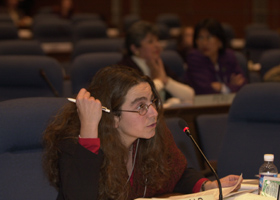 Regarding the recommendation on the work programme, the NETHERLANDS proposed having COP-6 decide on priorities, including definition of targets, timeframes and actors. |
||
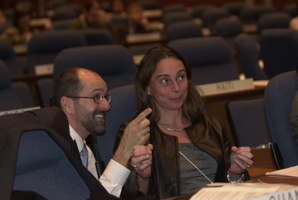 GERMANY proposed inviting the Secretariat to present SBSTTA's deliberations to the second UN Forum on Forests, which was questioned by MALAYSIA given lack of COP review. |
||
|
WORKING GROUP II: |
||
| AGRICULTURAL BIODIVERSITY: | ||
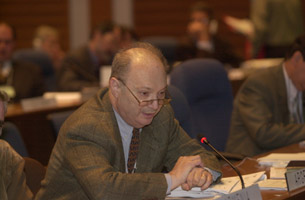 Regarding implementation of the work programme, ARGENTINA (left) emphasized full participation. |
||
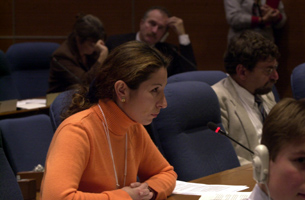 COLOMBIA referred to preventing adverse impacts of agriculture on biodiversity, and called for case-studies for the soil biodiversity initiative. |
||
|
|
||
| PLANT CONSERVATION STRATEGY: | ||
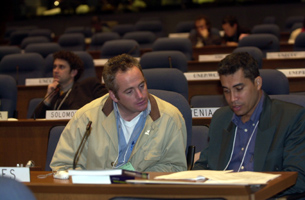 On the recommendation, ANTIGUA AND BARBUDA, JAMAICA and the SEYCHELLES (right) called for incorporating the strategy's implementation into existing CBD work programmes to avoid overburdening Parties. |
||
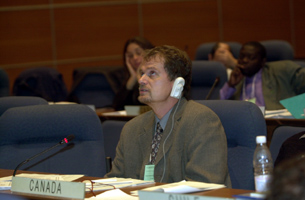 CANADA (right), with SPAIN, suggested that language on the Executive Secretary's refinement of the targets' quantitative elements include consultation with relevant international initiatives. |
||
| INCENTIVE MEASURES: | ||
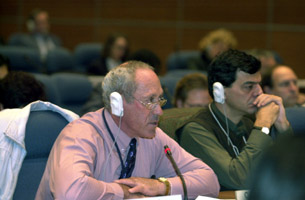 SOUTH AFRICA called upon the Executive Secretary to make information gathered on perverse incentives available to COP-6. |
||
| INDICATORS: | ||
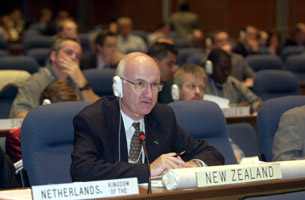 NEW ZEALAND, supported by BELGIUM, said the list of available and potential indicators should be quantitative and qualitative. |
||
| ENVIRONMENTAL IMPACT ASSESSMENT: | ||
|
|
||
|
|
||
| GLOBAL BIODIVERSITY OUTLOOK: | ||
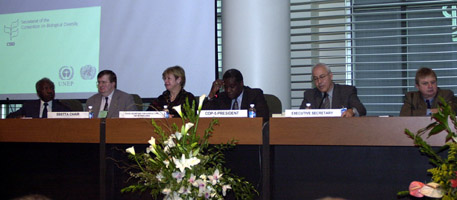 In
the afternoon, the Secretariat launched its first GBO, the CBD's report
on its activities and the status and trends of global biodiversity. Reuben
Olembo, UN Environment Programme, on behalf of the COP-5 President,
congratulated the Secretariat and highlighted the CBD's achievements
since UNCED. Hamdallah Zedan, CBD Executive Secretary, recalled SBSTTA's
initial recommendation regarding preparation of a periodic paper to
assess status and trends of global initiatives. In accepting the first
copy, Geke Faber, State Secretary of Agriculture, Nature Management and
Fisheries (the Netherlands) stressed the document's importance along
with challenges facing the Parties before COP-6. Jan Plesník, SBSTTA-7
Chair, said the GBO would help achieve the CBD's three main goals by
increasing knowledge about the status of management and sustainable use of
biodiversity. In
the afternoon, the Secretariat launched its first GBO, the CBD's report
on its activities and the status and trends of global biodiversity. Reuben
Olembo, UN Environment Programme, on behalf of the COP-5 President,
congratulated the Secretariat and highlighted the CBD's achievements
since UNCED. Hamdallah Zedan, CBD Executive Secretary, recalled SBSTTA's
initial recommendation regarding preparation of a periodic paper to
assess status and trends of global initiatives. In accepting the first
copy, Geke Faber, State Secretary of Agriculture, Nature Management and
Fisheries (the Netherlands) stressed the document's importance along
with challenges facing the Parties before COP-6. Jan Plesník, SBSTTA-7
Chair, said the GBO would help achieve the CBD's three main goals by
increasing knowledge about the status of management and sustainable use of
biodiversity. |
||
|
|
||
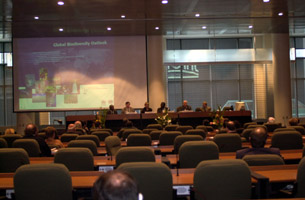
|
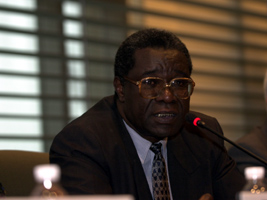
|
|

|
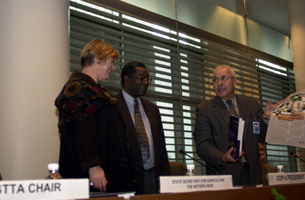
|
|
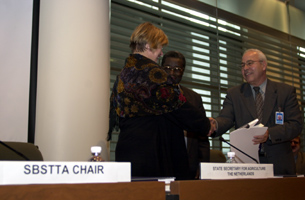
|
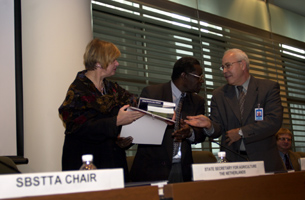
|
|
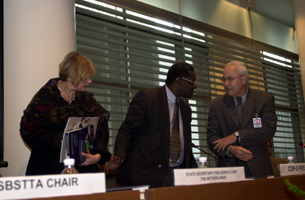
|
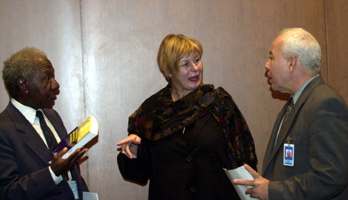
|
|
|
|
||
|
|
||
| © 2001, IISD. All rights reserved. |
|


